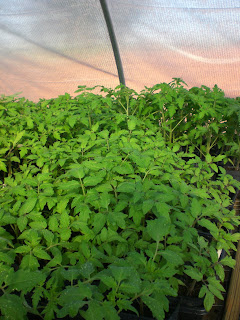
The dog day doldrums are lifting and there are signs that time indeed passes. No longer the ever-predictable, conk-you-in-the-mug sizzle of summer. The morning glories invite the midday rays that a week ago would have shriveled its silken cups. The patch of sungolds, given the chance to hold their blooms by the cooler night air, come alive like a hundred little suns switched back on. The first yellowing poplar and the red tips lining the understory of a barnside maple tell of a fairer fall all too near. The morning and evening skies are given depth by the darkening of the blue hues and we know there is much gathering to be done and, yes, seeds yet to s
The withered squash vines are stripped clean of their impossibly beautiful ornaments. The strange armored bugs that cling to them like members of some medieval butternut cult are swept off their buff skins and stomped in vain attempt to prevent their procreation. The pepper plants, many sprawled out over the ground from the weight of their prodigious growth, will be plucked of their peppers and eaten, sold or canned. Early fall tomatoes will see the same fate, their vines removed and destroyed to check disease. Basil will be gathered until the kitchen drips with sweet, pungeant perfume and pesto will join blueberries, tomato puree and peppers in the freezer. Melon vines, eggplants, legumes and other annual crops will succumb to the mower and the tines, and will return to the soil to feed the organisms that allowed them to grow and bear. Come early October, excepting those sections designated for the fall garden, summer growth will be cleared and tilled to make way for all-important winter rye. The rye will quickly establish itself in the cooler weather, growing alongside volunteer vetch, holding the topsoil through winter’s rains and come Spring its powerful roots will crowd out weeds and aerate the soil until its tops are mowed and integrated as green manure for next year’s bounty. The fall garden will also be “ryed” but not until late winter, and won’t be planted in vegetables until summer, if not left fallow.
As I write in mid-September the fall and summer garden harvest begins to overlap. The earliest greens of fall, arugula are approaching maturity, and in full form - free of flea beetles and their taste for spicy Spring greens. Radishes will be plucked alongside with the potential for some lively salads, something we’ve missed around here. (We made some attempts at growing Summer lettuces, with some limited success growing Jericho Romaine, but, well, the dry heat prevailed.) Surely it won’t be so hot and dry next year. Farmers. Always the eternal optimists…and surely I don’t speak too facetiously.
We’ve been graced with visitors human and animal this August and early September. Let me begin with our feathered friends. Beginning late July we heard the unmistakable sound of bobwhite quail calling nearby. Their calls have continued and remain very close, localized to an area on or near Harmony Ridge. Our neighbor says he hasn’t heard quail around Bowens Road in some twenty years. Their decline in the piedmont has been alarmingly precipitous. Their presence indicates a healthy diversity of flora and habitat necessary to support their survival. Their decline is not surprising considering the widespread use of herbicides and the perpetual mowing of any land not in crop or woods. Quail need a combination of woodlands, brush, grass and croplands. They like the in-between places: fencerows and the brushy sumac and briar stands at the edge of forests. They particularly enjoy seeds, produced in great numbers by sheltering weeds. Anyone that has visited our farm since July knows quail will feel right at home here. I’m also encouraged to find out that quail will spend around 75 percent of their lives within a ½ mile foraging range. This means the covey that we’ve so enjoyed hearing could call Harmony Ridge (and its unkempt beauty) home.
As for those visitors of the human persuasion, we’ve had quite a few of late, some of them quite helpful. In early August, CSA members Keith and Rebecca Ammons brought their nieces (in town from Wisconsin) to help with farm chores. We were able to clear an overgrown vegetable bed that is now supporting beet, carrot and arugula. A few weeks later I got an e-mail from a guy, like me, having two first names, Grant and Doug. Turns out he just moved to the area and wants to spend time helping at the farm. I say O.K! On labor day, a group of special needs folks visited and helped harvest. It was a truly wonderful experience for (I hope) all in attendance. An especially enthusiastic member of the crew, Jeremy, showed up clad in John Deere gear ready to jump on our loaner tractor and till up the bottomland. I would like to thank Christina of Dragonfly Farms for coordinating their visit, as I’m sure it won’t be the last.
Let me sp eak just a bit more about our fall garden. We left part of our main plot on the hill fallow this summer, finally tilling the rye in early August – by this point a tangled stubble. We were pleased and somewhat surprised at the degree to which the soil beneath had responded to our cover cropping and fall greensand treatment. What was last August near-hardpan clay, is now a red loam, still in need of additional organic matter, but certainly quite workable. So we’ve planted it in fall crop: broccoli, green and red cabbage, kale, beets, onion, carrots, radishes, arugula, spinach, tatsoi, mustard greens, collards and turnips. And soon Chinese cabbage, lettuces and bok choi will be ready for transplanting. I plan on offering fall produce at the downtown Krankies market on Tuesdays. Although, if I had enough interest from customers wanting to purchase produce on-farm, I may just open up shop at Harmony Ridge…I will keep you posted on our plans for fall. Perhaps a Saturday morning farmstand? I should mention also that our last week for CSA shares is fast approaching: we will wrap up our 2010 CSA season Friday, October 1st.
eak just a bit more about our fall garden. We left part of our main plot on the hill fallow this summer, finally tilling the rye in early August – by this point a tangled stubble. We were pleased and somewhat surprised at the degree to which the soil beneath had responded to our cover cropping and fall greensand treatment. What was last August near-hardpan clay, is now a red loam, still in need of additional organic matter, but certainly quite workable. So we’ve planted it in fall crop: broccoli, green and red cabbage, kale, beets, onion, carrots, radishes, arugula, spinach, tatsoi, mustard greens, collards and turnips. And soon Chinese cabbage, lettuces and bok choi will be ready for transplanting. I plan on offering fall produce at the downtown Krankies market on Tuesdays. Although, if I had enough interest from customers wanting to purchase produce on-farm, I may just open up shop at Harmony Ridge…I will keep you posted on our plans for fall. Perhaps a Saturday morning farmstand? I should mention also that our last week for CSA shares is fast approaching: we will wrap up our 2010 CSA season Friday, October 1st.
We’ve mixed things up of late, harvesting some different legumes: crowder peas (close relative to the black-eyed pea) and limas. We hope you’ve enjoyed them, particularly the limas, as they require a good four hours of three pairs of hands picking. If our next batch is able to mature in the (somewhat) cooler weather, we will be able to offer more…by request this time.
CSA plus members will be receiving organic apples this week: a mixed bag of just-picked Jonagold, Crispin, Red and Green Delicious and Winesaps from Fairview, NC. For those interested in purchasing extra, they are $2 a Lb. (Limited quantities available.)
They are not unblemished, but are certainly not lacking for flavor.
One of this week’s spotlighted vegetables was okra. Turns out we ran a little short to provide okra to everyone this week. Those not receiving it should expect to see those lovable “ladies fingers” in next week’s share box.
A couple more CSA announcements…if you want extra sweet or hot peppers for cooking, freezing, drying, canning, or stacking into pepper towers please let me know. There is also a load of basil. If you’d like enough for pesto this upcoming week just say the word. And speaking of basil, we will be processing another batch of holy basil tea. If you tried it and liked it and want more I can include a more generous amount in this week’s box.
Lastly, an announcement to all CSA members and “civilians at-large”: I will be e-mailing a weekly “menu” for produce available for purchase on-farm. The menu will be sent out Fridays for pick-up Saturday at a time TBA. If you wish to receive a weekly menu, please let me know.
Thank you all again for your unwavering support and have a splendid weekend.
-K. Isaac Oliver
An early September CSA share / The Ammons family and I.













































